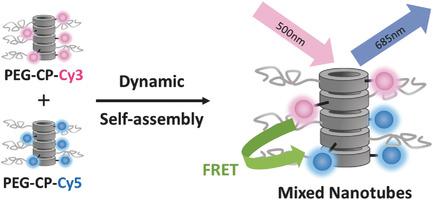当前位置:
X-MOL 学术
›
Adv. Funct. Mater.
›
论文详情
Our official English website, www.x-mol.net, welcomes your
feedback! (Note: you will need to create a separate account there.)
Probing the Dynamic Nature of Self‐Assembling Cyclic Peptide–Polymer Nanotubes in Solution and in Mammalian Cells
Advanced Functional Materials ( IF 18.5 ) Pub Date : 2017-11-07 , DOI: 10.1002/adfm.201704569 Julia Y. Rho 1 , Johannes C. Brendel 1 , Liam R. MacFarlane 2 , Edward D. H. Mansfield 1 , Raoul Peltier 1 , Sarah Rogers 3 , Matthias Hartlieb 1 , Sébastien Perrier 1, 4, 5
Advanced Functional Materials ( IF 18.5 ) Pub Date : 2017-11-07 , DOI: 10.1002/adfm.201704569 Julia Y. Rho 1 , Johannes C. Brendel 1 , Liam R. MacFarlane 2 , Edward D. H. Mansfield 1 , Raoul Peltier 1 , Sarah Rogers 3 , Matthias Hartlieb 1 , Sébastien Perrier 1, 4, 5
Affiliation

|
Self‐assembling cyclic peptide–polymer nanotubes have emerged as a fascinating supramolecular system, well suited for a diverse range of biomedical applications. Due to their well‐defined diameter, tunable peptide anatomy, and ability to disassemble in situ, they have been investigated as promising materials for numerous applications including biosensors, antimicrobials, and drug delivery. Despite this continuous effort, the underlying mechanisms of assembly and disassembly are still not fully understood. In particular, the exchange of units between individual assembled nanotubes has been overlooked so far, despite its knowledge being essential for understanding their behavior in different environments. To investigate the dynamic nature of these systems, cyclic peptide–polymer nanotubes are synthesized, conjugated with complementary dyes, which undergo a Förster resonance energy transfer (FRET) in close proximity. Model conjugates enable to demonstrate not only that their self‐assembly is highly dynamic and not kinetically trapped, but also that the self‐assembly of the conjugates is strongly influenced by both solvent and concentration. Additionally, the versatility of the FRET system allows studying the dynamic exchange of these systems in mammalian cells in vitro using confocal microscopy, demonstrating the exchange of subunits between assembled nanotubes in the highly complex environment of a cell.
中文翻译:

探索溶液和哺乳动物细胞中自组装环肽聚合物纳米管的动态性质
自组装环状肽-聚合物纳米管已成为一种引人入胜的超分子系统,非常适合各种生物医学应用。由于它们的明确定义的直径,可调节的肽解剖结构以及原位分解的能力,它们已被研究为包括生物传感器,抗微生物剂和药物递送在内的许多应用的有前途的材料。尽管付出了这些不懈的努力,但组装和拆卸的基本机制仍未完全了解。特别地,到目前为止,尽管已组装的纳米管之间的单元对于了解不同环境下的行为至关重要,但在各个组装好的纳米管之间的单元交换却一直被忽略。为了研究这些系统的动态性质,合成了环状肽-聚合物纳米管,并与互补染料共轭,经历了紧密的Förster共振能量转移(FRET)。模型共轭物不仅能够证明其自组装是高度动态的,而且不会在动力学上被困住,而且还证明了共轭物的自组装受到溶剂和浓度的强烈影响。此外,FRET系统的多功能性允许使用共聚焦显微镜在体外研究哺乳动物细胞中这些系统的动态交换,证明了在高度复杂的细胞环境中组装的纳米管之间的亚基交换。但是,结合物的自组装也受到溶剂和浓度的强烈影响。此外,FRET系统的多功能性允许使用共聚焦显微镜在体外研究哺乳动物细胞中这些系统的动态交换,证明了在高度复杂的细胞环境中组装的纳米管之间的亚基交换。但是,结合物的自组装也受到溶剂和浓度的强烈影响。此外,FRET系统的多功能性允许使用共聚焦显微镜在体外研究哺乳动物细胞中这些系统的动态交换,证明了在高度复杂的细胞环境中组装的纳米管之间的亚基交换。
更新日期:2017-11-07
中文翻译:

探索溶液和哺乳动物细胞中自组装环肽聚合物纳米管的动态性质
自组装环状肽-聚合物纳米管已成为一种引人入胜的超分子系统,非常适合各种生物医学应用。由于它们的明确定义的直径,可调节的肽解剖结构以及原位分解的能力,它们已被研究为包括生物传感器,抗微生物剂和药物递送在内的许多应用的有前途的材料。尽管付出了这些不懈的努力,但组装和拆卸的基本机制仍未完全了解。特别地,到目前为止,尽管已组装的纳米管之间的单元对于了解不同环境下的行为至关重要,但在各个组装好的纳米管之间的单元交换却一直被忽略。为了研究这些系统的动态性质,合成了环状肽-聚合物纳米管,并与互补染料共轭,经历了紧密的Förster共振能量转移(FRET)。模型共轭物不仅能够证明其自组装是高度动态的,而且不会在动力学上被困住,而且还证明了共轭物的自组装受到溶剂和浓度的强烈影响。此外,FRET系统的多功能性允许使用共聚焦显微镜在体外研究哺乳动物细胞中这些系统的动态交换,证明了在高度复杂的细胞环境中组装的纳米管之间的亚基交换。但是,结合物的自组装也受到溶剂和浓度的强烈影响。此外,FRET系统的多功能性允许使用共聚焦显微镜在体外研究哺乳动物细胞中这些系统的动态交换,证明了在高度复杂的细胞环境中组装的纳米管之间的亚基交换。但是,结合物的自组装也受到溶剂和浓度的强烈影响。此外,FRET系统的多功能性允许使用共聚焦显微镜在体外研究哺乳动物细胞中这些系统的动态交换,证明了在高度复杂的细胞环境中组装的纳米管之间的亚基交换。











































 京公网安备 11010802027423号
京公网安备 11010802027423号